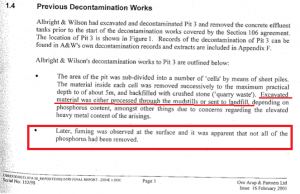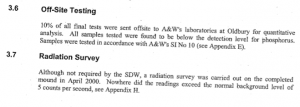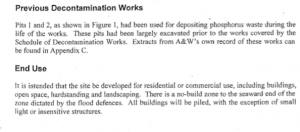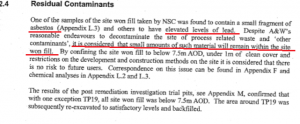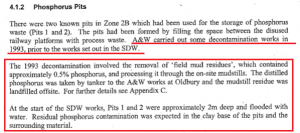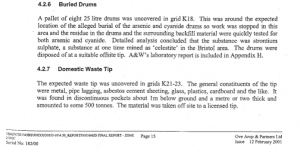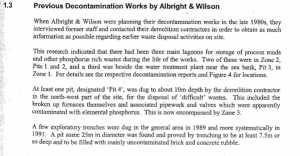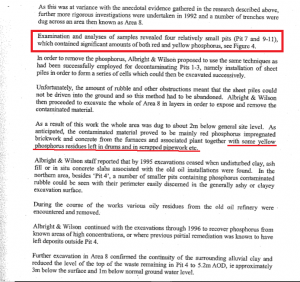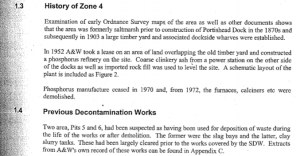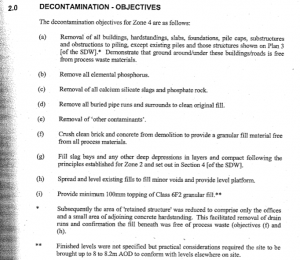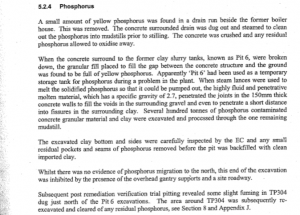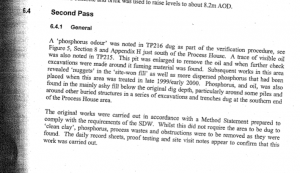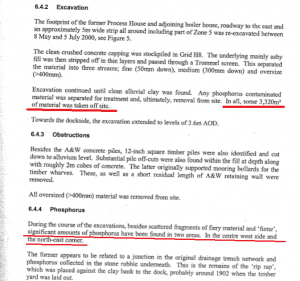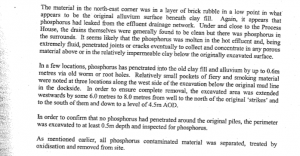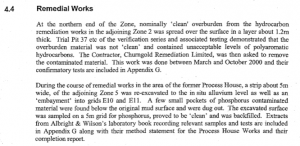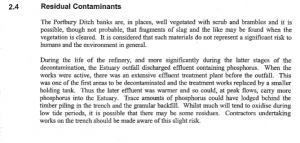Albright and Wilson Portishead site remediation
BACKGROUND
Albright and Wilson’s Portishead site was built to increase post war production capacity of white phosphorus. Being near Bristol, its location was ideally placed for receipt of phosphate rock shipments with a nearby power station and rail connections. The first Portishead phosphorus furnace started in February 1954. There were many operation problems related to this plant during its operation and these were repeated in the company’s disastrous Long Harbour operation which meant that the furnaces on the coast were restarted.
Phosphate rock was eventually delivered from Florida using a 10,000 ton cargo ship called imaginatively “Arthur Albright”.
WHAT DID WE ASK AND WHAT DID THEY KNOW?
We asked North Somerset Council as the authority on which the former site is based a number of questions relating to the decommisioning and remediation of the site. The council responded to this request supplying a number of reports relating to the site.
“I am requesting what information you hold relating to
1 white phosphorus contamination of the site (yellow phosphorus or P4), and the extent of the contamination on the site, in the form of samples taken from sediment/soil analysis and other artefacts recovered from the company’s activities.
2.Information relating to the lagoons on site, the extent of their contamination by white phosphorus and other materials.
3. How these lagoons were remediated to make them safe and what problems were encountered during this process?
The following reports were supplied by the council. They are broken down into the individual 6 zones allocated for the site.
ZONE 4 part 1 ZONE 4 part 2 ZONE 4 part 3
4. How long did the remediation of the Portishead site take what was the final cost and who paid for this?
“Albright and Wilson commenced remediation works in 1989 which carried on until 1996, however full remediation of the site wasn’t begun until 1997 through the Schedule of Decontamination Works. Validation reports for the remediation were completed for each area of the site in 2000. Further validation works were then carried out between 2000 to 2008 as part of ongoing work and development of the extension to the dock. There is still a small area of the site to be remediated around the former offices of Albright and Wilson which still exist on the site.
The remediation was carried out by Albright and Wilson (later to become Rhodia Specialities Ltd) and Bristol City Council who were the land owner. North Somerset Council was only involved as the planning authority and oversaw the works to ensure that the remediation was carried out to the standard required by the planning obligations in the Section 106 agreement for the site. We therefore do not have any record of how much the remediation cost.”
5. Aside from the Strode Road site in Clevedon, are you aware of any other waste sites used by Albright and Wilson at their Portishead site for disposal of waste, containing white phosphorus?
Or did they use any other sites for waste tipping activities and what is the current status of these sites?
“North Somerset Council is not aware of any other site, aside from Strode Road in Clevedon where Albright and Wilson disposed of any phosphorus containing waste.”
WHAT DOES THIS MEAN?
The decontamination works by Albright and Wilson are reported from the response to have taken 7 years- between 1989 and 1996. This is at odds with what former PR spin doctor ad Oldbury Works manager Peter Bloore stated in an Albright World article in the early 1990’s, in that work on decommissioning at Portishead had actually started with the closure of the furnaces in 1972. The serious white phosphorus fire (200 barrels) occurred during this claimed period in 1990. Further works occurred after this, though what and who oversaw Albright and Wilson’s work remains unclear. From our observations in how little information they gave to external consultants about rattlechain in 1990 (Cremer and Warner) , as well as the then Health protection Agency in their so called “clean up works”, one wonders about the confidence of how they went about this.
The council were unable to confirm if this company had used any other satellite waste dumps in the area other than the Strode Road site for their Portishead factory waste arisings.
The most interesting detail is contained in the decontamination zone reports, and we have looked at these in order highlighting the most important points- specifically about white phosphorus contamination found throughout the site. It is also worth reading these in conjunction with a report DECONTAMINATION AND REMEDIATION WORKS AT ALBRIGHT & WILSON, PORTISHEAD by Martyn John Duffin. The consultancy OVE Arup were appointed by the consortium overseeing the works as environmental consultants.
Arup_Decon and Remed Portishead UK_200_[4][1]
“Albright & Wilson had started ‘decontamination’ works in a small way in the early 1990s prior to Arup’s involvement by, amongst other things, carrying out an archive search for details of any disposal pits as well as contacting former workers. From this work they prepared a plan marked up with a number of suspected pits together with a schedule of other potential hazards. These included reports of there being drums of cyanide and other toxic waste buried on the site as well as a dragline crane which had apparently fallen irretrievably into one large pit. “
Six individual zones were allocated for the site.
At 1.1 We are told the work was carried out between January and September 1998
1.2 The history of the site should be read with caution given Albright and Wilson’s selective amnesia given at rattlechain. Previous use was as an oil refinery and railway line prior to AW use. “AW built concrete effluent treatment tanks , excavated a pit for process waste disposal and made surface deposits of waste during their occupation.”
1.4 AW had removed concrete tanks and pit 3 . Removed debris to 5 metres but backfilled this with crushed stone quarry waste. This was sent to landfill- but which one?
“Later fuming was observed at the surface and it was apparent that not all of the phosphorus had been removed”.
At 1.5 “the site is not suitable for building development.”
Unfortunately at 3.6, we are told that Albright and Wilson themselves were allowed to mark their own work with tests for white phosphorus being carried out at Oldbury. That any of these were either independent or honest results has to seriously be questioned.
This is especially true when considering how this company had been fined for recovering phosphorus in the waste at Portishead for transport to Oldbury and had actually enriched the radioactive content in the method that they conducted. No where in the OVE ARUP report is this fact ever mentioned, and so we can only assume that it was another of the relevant points that Albright and Wilson missed out on telling them. I still find it however remiss of this environmental consultant and the development consortium in not mentioning this important point, or requiring a radioactive survey.
This zone as above states the previous use prior to AW being the oil refinery and railway sidings. They used it for stock piling and also dug pits to store waste arisings.
Interestingly at 1.4 we are told that two of these pits were used for “depositing phosphorus wastes”. Albright and Wilson had removed these BEFORE Ove Arup had appeared on the scene- but where did they remove this waste to I wonder?
This area was to see residential development on landscaping built on top.
High levels of hydrocarbons were found , as evidenced at 1.7.2.
At 2.1 we are told of Albright and Wilson’s remediation site objectives.
Despite the claims of Albright and Wilson to restore the site to the condition that it had been in before they arrived, the hollowness of this promise is encapsulated by the whimsical defence of OVE ARUP. Despite finding asbestos and elevated levels of lead in the bogus “site won fill” that was supposedly “clean”, it was decided to just bury this inconvenient matter under 1 meter of “clean cover”.
This part continues the zone two description which is spilt into zone 2 a , b and c.
The most interesting part of this is the very vague description offered of Albright and Wilson’s activity into removing phosphorus waste in the area 2b in 1993 in two “phosphorus pits”- before anyone else came on the scene. This therefore cannot be independently verified.
It is stated that these were “mud residues” and that they contained 0.5% white phosphorus. Crucially the volumes are not given, so this is a misleading statement. The distilled phosphorus was taken to Oldbury- however it also states that the mudstill residues were “landfilled offsite”.
There is nothing here which does not suggest to me that this waste was landfilled at Rattlechain lagoon. I believe that a picture of these was shown in Albright World at around this time, with many false statements made by PR spin doctor and Oldbury works manager Peter Bloore- but not anything about the fine that the company had faced for causing radioactive contamination through the recovery of phosphorus that this method describes!
At 4.2.4 White phosphorus is described being encountered in the clay and fill from the pits. Both contaminated p4 crushed drums and phossy water were found. One wonders if thee were from the 1990 fire?
More revelations are described in the form of buried drums, thought to have contained arsenic and cyanide, but which instead it is claimed contained strontium sulphate. One remembers Albright and Wilson’s claim that they had no responsibility for dumping cyanide drums when it was found at rattlechain and the gower tip in 1972. One wonders whether this was a truthful statement under these circumstances. It is also stated once again that the chemical in this situation at Portsihead, which it is not adequately described how it even got there “were disposed of at a suitable offsite tip”.
Another Albright and Wilson “domestic tip” contained amongst other things asbestos contaminated material totalling 500 tonnes. Once again we are reminded as to how negligent an employer AW were over this substance. Once again- this is taken to the unnamed “licenced tip”.
More bagged asbestos waste was found lying around the site as “general waste” . At this point in time, Albright and Wilson had shown around groups of students not employed by the company amongst other visitors. Once again this unnamed volume of dangerous cancer causing material appears to have “gone to the tip.”
At zone 2c p4 was found in fill below a slab base, mainly as phossy water and also as “phosphorus concrete”. Th explanation of this is that phosphorus contaminated material may have been washed down here, so there was an inadequate way of dealing with this during the phosphorus factory occupation.
Concern must be expressed about off site testing, carried out by Albright and Wilson at Oldbury. One must question what advantage was there in finding any phosphorus contamination for this dishonest company in their labs?
This part of the report is perhaps the most revealing as to the total incompetence of Albright and Wilson and their “decommissioning” operations.
At 1.3 Ove Arup do their best to try to spin something which doesn’t quite work, and leaves one asking serious questions.
Firstly AW appear to have placed everything on the memories of their still alive site workers. It confirms (only on what was admitted) that there were three on site waste lagoons . Two were in zone 2 as discussed and one in Zone one. But there was another for so called “difficult wastes” which was located in this zone 3. This had been constructed by Albright and Wilson’s unnamed contractors to a limited depth of 10 metres. It contained the broken up furnaces and piping contaminated with white phosphorus.
It appears that the idiots had then buried the pit with rubble on top if this! So much for the claims made in Albright World about this decommissioning operation!
“Significant amounts of both red and yellow phosphorus” were found.
The AW plan to remove this however failed due to the rubble that had buried it. At this point perhaps a serious consultant would have asked some more searching questions about AW’s shabby operations up to that point rather than trying to put some defensive gloss over it.
Excavation revealed more drums containing p4. All of these subsequent operations occurred AFTER the Cremer and Warner report site investigation of Rattlechain in 1990, and within the time period that the Environment agency have stated that the last deposits made by AW into rattlechain containing p4 contaminated material was dumped. There is nothing to exclude the possibility that they took this waste to Oldbury, just as they did with the recovered phosphorus.
Only 2-3 pages are contained in this, and it is only noteworthy to record that once again it refers at 4.4 it records that just 10% of recovered materials, JUST ONE SAMPLE FOR THIS DESCRIBED “DIFFICULT WASTES” IN ZONE 3 WERE SENT TO ALBRIGHT AND WILSON’S LABORATORIES FOR TESTING. As far as I am concerned this was not good enough and neither was it good enough that an environmental consultant and local authority thought that this was acceptable either!
This zone is again referred to as part of the phosphorus factory and was built on a former marsh area and timber yard. It is stated here , as Peter Bloore had stated in Albright World that deconstruction of the furnaces had started in 1972. But this source like that of what Albright and Wilson claimed to have done cannot be verified independently.
The one was split into 5 subzones to eventually allow residential development or buildings. The objectives were described as
Within zone 4A white phosphorus was again found.
In zone 4b we are informed as if in passing that there had been another fire in 1995. Caused by what I wonder? 🙄 It is also stated that a stream of phosphorus ran form an old drain system into the Portbury ditch.
In zone 4c once again problems with p4 were found. This demonstrates just how powerful this molten insidious chemical is, even penetrating the clay. “Several hundred tonne of phosphorus contaminated concrete granular material and clay were excavated and processed through the one remaining mudstill. “
In zone 4 d, the process house, again white phosphorus was found.
It is apparent that white phosphorus suspected of being removed actually wasn’t. This unfortunately confirms how poor the decision was by all concerned, including Ove Arup to base presence of p4 on visible “fuming” alone. I would describe this as just lazy and dangerous speculation.
It is stated that the missed area had 3,320m3 of material taken off site- again where was this site?
It is revealed that the molten phosphorus had penetrated 60 cm of clay, thus perhaps proving to all those “experts” who consider clay to be impermeable , especially in clay pits to this substance that they are talking out of their backsides.
At 1.3 we are told that this area was a concrete structure and a muddy foreshore. When Albright and Wilson came on the scene they formed wharf 3 at Portishead docks. It appears that Albright and Wilson removed the rail lines and some phosphorus storage tanks adjoining the process house before decontamination.
White phosphorus was found in the mud on excavation and removed to a depth of 4.5 metres.
This area is identified as including “The Portbury ditch” built before the docks were created and which collected surface water. During the decontamination works , stockpiled material caused a failure in the slope.
It is revealed that more p4 contaminated material was removed by Albright and Wilson prior to 1995 “approximately 20 tonnes”. The glib conclusion about no phosphorus being present in other areas is again noted, when IT HAD BEEN MISSED in other areas of this site.
The final paragraph in this report is perhaps very revealing in this “decontamination” of this site. “During the life of the refinery, and more significantly during the later stages of the decontamination, the Estuary outfall discharged effluent containing phosphorus”.
“Trace amounts of phosphorus could have lodged behind the timber piling in the trench and the granular backfill. Whilst much will tend to oxidise during low tide periods, it is possible that there may be some residues. Contractors undertaking works on the trench should be made aware of this light risk.”
Assumptions unfortunately appear to form a great part of this report and decontamination of this site.
CONCLUSION
Perhaps the most negligent part of this process was the abysmal “method” of detecting white phosphorus contamination at this site, and somehow believing that lack of fume= no phosphorus contamination. This is a ludicrous approach to take, and as evidenced in zone 4 proved to expose the consultants. One can have little confidence that areas deemed “free” of p4 actually really were, even when backfilled with so called “clean cover” that may also have been contaminated but not identified to contain P4.
The lamentable excuses concerning wet weather for missing this dangerous contamination could have occurred in all the zones and resulted in not identifying any p4 by lack of fuming, and the fact that the back up plan of allowing AW to test just 10% of off site samples, to mark their own work, is hardly cause for credible certainty that the objective had been achieved.
So many tonnes of contaminated material are described as having been removed off the site- waste contaminated with white phosphorus- but to where? It appears to have continued into the Rhodia era when the senior French Monsieur executives are reported to have cursed when they found out the liabilities that AW had left them with and not told them about with sites like this. I see nothing here to allay my fears that this commercial gain sell off for AW and then Rhodia resulted in large amounts of this “phosphorus contaminated material” heading to Rattlechain lagoon and dumped under water to poison the birds.
Unfortunately the devil in the detail was missing from this request in the form of the appendices which are referred to in the zone reports. These give method statements and readings. It would have been useful if the council had have included these in the response, but they didn’t. A more recent request to this council for these appendices has revealed that the council claim that they no longer hold this report. How very convenient.


